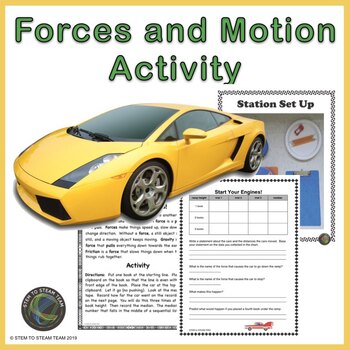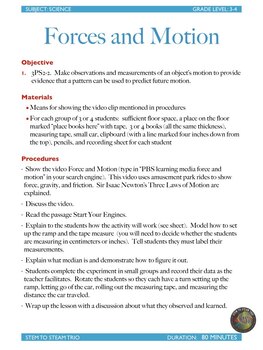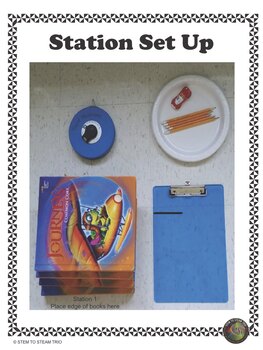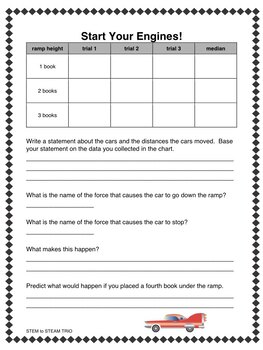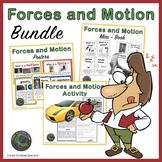Forces and Motion STEM Challenge
Science and STEAM Team
2.3k Followers
Grade Levels
3rd - 5th
Subjects
Resource Type
Standards
CCSS2.MD.A.1
CCSSRI.3.10
NGSS3-PS2-1
NGSS3-5-ETS1-3
NGSS3-PS2-2
Formats Included
- PDF
Pages
6 pages
Science and STEAM Team
2.3k Followers
What educators are saying
Thank you for this resource! My students loved it and were completely engaged. Science should be fun and this resource does just that!
Also included in
- This science resources will provide your students with force and motion examples. There are force and motion posters, a corresponding mini-book, and a force and motion activity that your students will love!Price $10.00Original Price $12.25Save $2.25
Description
This science downloadable, force and motion activity, was designed to be used with second through fourth-grade classes. A lesson plan aligned to the Next Generation Science Standards, a picture of the station set up, reading passage and recording sheet for this hands-on STEM are included.
3PS2-2
Related Resources
⭐ Forces and Motion Posters for elementary grades
⭐ Forces and Motion Mini Booklet
⭐ Third Grade NGSS 3-PS2: Motion and Stability and Forces and Interactions Unit
⭐ Car Engineering Challenge Using Building Bricks
⭐ Accountable Talk Posters for the Science Lab
⭐ Famous People in the Area of STEAM Posters for Elementary Grades
Total Pages
6 pages
Answer Key
N/A
Teaching Duration
90 minutes
Report this resource to TPT
Reported resources will be reviewed by our team. Report this resource to let us know if this resource violates TPT’s content guidelines.
Standards
to see state-specific standards (only available in the US).
CCSS2.MD.A.1
Measure the length of an object by selecting and using appropriate tools such as rulers, yardsticks, meter sticks, and measuring tapes.
CCSSRI.3.10
By the end of the year, read and comprehend informational texts, including history/social studies, science, and technical texts, at the high end of the grades 2–3 text complexity band independently and proficiently.
NGSS3-PS2-1
Plan and conduct an investigation to provide evidence of the effects of balanced and unbalanced forces on the motion of an object. Examples could include an unbalanced force on one side of a ball can make it start moving; and, balanced forces pushing on a box from both sides will not produce any motion at all. Assessment is limited to one variable at a time: number, size, or direction of forces. Assessment does not include quantitative force size, only qualitative and relative. Assessment is limited to gravity being addressed as a force that pulls objects down.
NGSS3-5-ETS1-3
Plan and carry out fair tests in which variables are controlled and failure points are considered to identify aspects of a model or prototype that can be improved.
NGSS3-PS2-2
Make observations and/or measurements of an object’s motion to provide evidence that a pattern can be used to predict future motion. Examples of motion with a predictable pattern could include a child swinging in a swing, a ball rolling back and forth in a bowl, and two children on a see-saw. Assessment does not include technical terms such as period and frequency.

